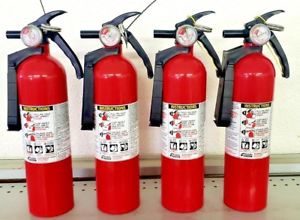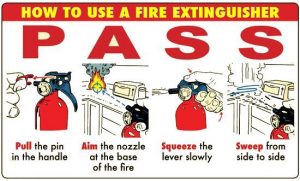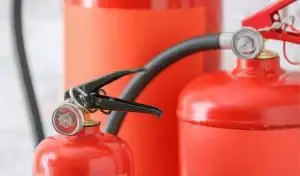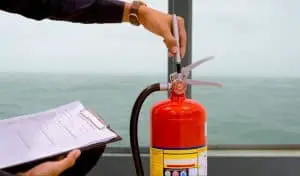Fire Extinguishers Are the Best Safety Investment You Can Make for Your Boat
It’s a no-brainer that every boat should have a fire extinguisher among its equipment. A fire extinguisher is there to protect our lives and, hopefully, our vessels. Can we ever have too many? The fact is that a boat fire can spread at breakneck speed–expanding by 100 percent every seven seconds. Easy access to an extinguisher is the difference between minimal damage and devastating destruction.
Federal regulations, enforced by the United States Coast Guard (USCG), call for every boat with an engine and fuel tank to carry at least one B-1 fire extinguisher–B referring to the agent that suppresses gasoline fires; 1 is the smallest in terms of content quantity–on board. Yet one might not be sufficient for larger vessels. These boats, between 26 and 40-feet long, require at least two. This requirement, however, can be modified to one if the craft has a built-in, USCG-certified fire quenching system for the engine compartment.
Is One Fire Extinguisher Better than the Others?
We advise that boaters go beyond the minimal federal guidelines and keep a 1A:10BC extinguisher on board as an extra safety precaution. Also known as a tri-class fire extinguisher, this type applies to fuel, electrical and standard fires caused by ordinary combustible materials, and can put out a fire covering over 10 square feet.
It is likely that most boaters are not experienced in using a fire extinguisher properly. Everyone should invest some time reading the instructions for use of the fire extinguisher. They can show you the potential of this equipment…and its limitations, as well.
Fire Extinguisher Quantity and Type
 The size of your boat affects the number of fire extinguishers you need. Larger boats need more fire fighting capacity which means more extinguishers are required.
The size of your boat affects the number of fire extinguishers you need. Larger boats need more fire fighting capacity which means more extinguishers are required.
- 1 B-1 for boats less than 26 feet
- 2 B-1s or 1 B-2 for boats between 26 and 40 feet
- 3 B-1s or 2 B-2s for boats between 40 and 65 feet
For comparison purposes: a B-1 fire extinguisher holds 1.25 gallons of foam and a B-2 unit holds 2.5 gallons. Remember, these are the minimum requirements. Safety is not an area where you want to cut corners.
First Alert Marine Fire Extinguisher
Proper Type of Fire Extinguisher for a Boat
Not all fire extinguishers are alike. They use different types of extinguishing agents to put out different kinds of fires.
Fires vary by the cause and the material that is burning. There are four types of fires, or classes:
Class A: These fires involve solid materials such as wood, paper, cloth, rubber and plastics that do not melt.
Class B: These include combustibles like gasoline, diesel, oils, paints, wax, cooking fat and plastics that melt.
Class C: This type of fire involves electricity.
Class D: This is a special type of fire that involves flammable metals such as magnesium, aluminum, titanium, sodium and potassium.
Fire extinguishers are coded according to what kind of fire they are designed to fight. Fires feeding off wood and fiber differ from those feeding off fuel, and from those ignited by electricity. So, using an extinguisher the contents of which to not address the specific kind of fire will 1) be ineffective and 2) might actually feed the fire. The NPFA is a good resource to begin learning.
What Type of Fire is Most Likely to Occur on a Boat
On your boat, you are most likely dealing with a Class A or Class B fire. You need to make certain that the type of fire extinguisher you’re using is appropriate for the fire you’re trying to put out. For this reason, you need a type B fire extinguisher – this is a Coast Guard requirement.
Type B fire extinguishers use a foam which works extremely well for gasoline and diesel fires as well as galley grease fires – the type you’re likely to find on a boat. The foam is also effective with wood, cloth, and other solid fuel fires.
Coast Guard Approved 5 Pound ABC Dry Chemical Fire Extinguisher
Even though there is plenty of water on and around your boat, water is not the best agent to use when putting out a boat fire. You wouldn’t want to use water to put out a grease fire in your kitchen. Don’t believe me? Check out this video to learn more.
How Much Protection Do I Need?
If a fire breaks out in the galley, will your extinguisher last long enough to get the job done? Unfortunately, the standard issue, foot-long extinguishers that you find on almost any boat lasts about 12 seconds, if that. In many cases, the blaze will continue given the speed and scope of boat fires. Combine the flammable gasoline with the wooden planks, fabric sails and other materials that feed a fire and you have a scary situation on your hands, as seasoned sailors will attest. I recommend having twice the number of fire extinguishers required by the Coast Guard. For the minimal cost involved, you’ll have peace of mind that you can handle a fire emergency on the water.
How Do I Operate a Fire Extinguisher?
 So you bought a fire extinguisher for your boat. You may be asking How exactly is a fire extinguisher operated? Fire training authorities have developed a simple fire fighting technique called P-A-S-S. This is an acronym for the step-by-step procedures you should follow.
So you bought a fire extinguisher for your boat. You may be asking How exactly is a fire extinguisher operated? Fire training authorities have developed a simple fire fighting technique called P-A-S-S. This is an acronym for the step-by-step procedures you should follow.
- Pull the metal safety pin that locks the operating lever atop the cylinder.
- Aim the nozzle toward the base of the fire.
- Squeeze the operating lever, or handle. This pushes on an actuating rod that points the valve downward toward the nozzle.
- Sweep the spray from one side to the other repeatedly until the fire is out.
Mounting and Storing the Fire Extinguisher
Give a lot of thought to where you will mount a fire extinguisher on your boat. It should be as close as possible to where you’ll need it in the event a fire starts on your boat. Ideally, there should be an extinguisher mounted at every exit along with one adjacent to the engine compartment. When they are so arranged, you are able to back out to your escape path while fighting the fire at its source. Make sure to mount the galley fire extinguisher away from the stove.
When using an open motorboat, confirm that the extinguisher is visible and easily within reach. Fire extinguishers are more exposed here to weather and the elements. Marine-rated extinguishers come with non-corrosive brackets for stable attachment to vertical surfaces. Those without that designation may contain brackets subject to corrosion.
Fire Extinguisher Anatomy
Parts and Contents:
Firing Mechanism
Every fire extinguisher has a safety pin that prevents the equipment from functioning until it is withdrawn. Some manufacturers include a plastic tie to hold it in place in order to protect against accidental removal. Several product reviewers believe the plastic tie actually slows down the activation of the extinguisher.
Most of the designs we have evaluated are activated by two levers squeezed together. Yet a more basic firing mechanism is found on smaller 5-BC assemblies, more common aboard personal vessels. Whether plunger or trigger, manufacturers are careful not to allow the firing mechanism to exceed the width of the cylinder.
Gauges
Gauges on fire extinguishers reveal the pressure of the cylinder content. With the exception of carbon dioxide extinguishers, they are attached to most every type of unit. Most gauges are round and color-coded: when the dial is on the green section, the instrument is appropriately charged. Under the green means insufficient pressure. If it is over the green, the retardant inside is under too much pressure, posing a safety issue.
Even if unused, a fire extinguisher will lose its pressure with age. If you have one over 12 years old, you should replace it. The majority of extinguishers are not rechargeable–if the dial shows “discharged,” the equipment needs to go. Rechargeable fire extinguishers are serviced at the retailer or affiliate. They should be recharged after use.
Partial Discharge
When a fire extinguisher is activated, a gas cylinder release valve is pierced and the retardant agent is forced through the siphon and out of the nozzle with considerable power. Testing reveals that partial discharge of dry material can render the extinguisher unusable after several minutes. So, re-ignition of flames or the start of a new fire cannot be suppressed by an extinguisher that may or may not function.
Contents of the Extinguisher:
Dry Chemical Extinguisher
Pleasure boats commonly house dry chemical extinguishers because of their modest cost and easy use. These dry materials are employed to smother the fire by depriving it of oxygen. To do so effectively, however, requires a concentrated focus on the base of the fire. When the aim is elsewhere, eradication of the fire is often incomplete, calling for an additional extinguisher to finish the job. Dry ingredients can also leave a grimy residue and corrode electrical systems.
Halotron Replacement Extinguisher
Halotron is a fire-inhibiting gas that serves as a more environmentally benign replacement to halon. Displacing the oxygen necessary for fire to rage, halotron is safe and shows no evidence of harming the electrical or mechanical systems on board. They are optimal for engine compartments but are higher in price and more unwieldy to handle.
Myths About Boat Fire Extinguishers
As debunked by the BoatUS Foundation for Boating Safety and Clean Water:
Myth #1:
You can Refresh the contents by banging or tapping the cylinder. Maybe in the old days but no longer — modern materials can be neutralized by such handling.
Myth #2:
You must use a bracket to mount an extinguisher. Not mandated, but it is a good idea to keep it safe and intact.
Myth #3:
Fire extinguishers age and decay after one year; they need annual need replacement. If the charge dial is in the green zone, the nozzle is clear and the cylinder rust-free, you have time left.
Myth #4:
Legally, you only need one extinguisher on board. Yes and no: a boat 26-feet long and under is OK with one per federal regulations. Larger boats must have more. Go to BoatUS.org/equipment for specific rules. At any rate, opt for multiple extinguishers, if possible.
Fighting Fires 101
Fires have different causes and sources. Putting them out requires different methods.
Engine Fires:
Over 50 percent of watercraft fires are rooted in the fuel delivery and/or electrical systems. The fuel lines must be closed, the engine turned off and the batteries switched off. Without a Fire-Port, the engine cover should be opened gingerly for the extinguisher to be inserted and activated. This activity should repeat until the fire is out. Dry chemical extinguishers are less effective in these cases since it is difficult to aim at the base of the flames. Accordingly, ABCY suggests Halotron extinguishers that stifle combustion or displace the oxygen supply.
Electrical Fires:
Switch off both engine and batteries. Apply dry chemical retardant, but avoid water by all means.
Fuel Fires:
The first order of business is to shut off the flow of gasoline (or alternative fuel). It manageable, throw a blanket on the fire to suffocate it. Again, do not use water.
Galley Fires:
Turn off the propane valve right away. Keep the oven closed and the pans covered to contain any flames. Preferably, a fire blanket should cover the stovetop, but an extinguisher will work, too. No water here, either.
Fires Below Deck:
If you can confirm it is neither an electrical nor fuel-based combustion, close any openings through which the fire can draw oxygen (while taking care to avoid smoke inhalation). Here is where water is a great suppressor, as is a fire blanket or a type-A fire extinguisher. Open hatches and closets slowly before applying any dousing agent.
The Last Resort:
Issue a mayday call over the radio while donning life vests and arranging to abandon the vessel.





